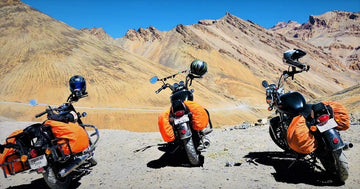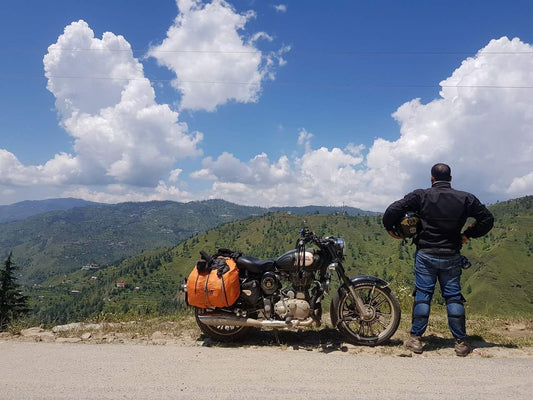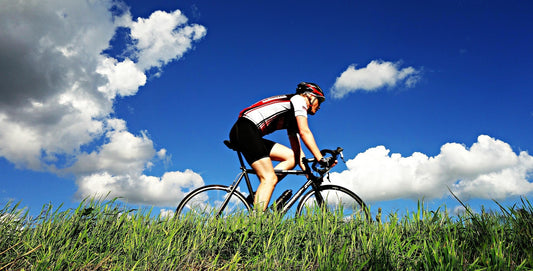Cycling Bags – A Comprehensive Buying Guide for Hobbyists
When it comes to cycling adventures, having the right gear is crucial.
One essential item that every cyclist needs is a reliable and functional cycling bag.
Be it cycling for daily errands or for long-distance tours, a well-designed cycling bag can make all the difference in terms of convenience and comfort.
In this guide, we will explore the various type of cycling bags available, discuss the factors to consider when buying one and highlight the top features to look for before you make the final decision to buy one.
Types of Cycling Bags
Before diving into the factors to consider when purchasing a cycling bag, let's first familiarize ourselves with the different types available.
Cycling bags come in various shapes and sizes, each designed to cater to different needs and preferences.
- Handlebar Bags: These bags attach to the handlebars of your bike and are ideal for storing small essentials like keys, wallets, and snacks. They offer easy access while riding and are often equipped with clear map holders for navigation purposes.
- Frame Bags: Frame bags, also called tri-frame bags, are designed to fit within the triangle of your bike frame. They are perfect for carrying heavier items such as tools, spare tubes, and extra clothing. Frame bags are known for their stability and low center of gravity which helps maintain balance while riding.
- Pannier or Saddle Bags: Panniers are large bags that attach to racks mounted on the front or rear of your bike. They offer ample storage space and are commonly used for long-distance touring or commuting. Panniers can be easily detached and carried like a regular bag when off the bike.
- Backpacks: Backpacks are a versatile choice for cyclists who prefer to carry their belongings on their back. They are available in various sizes and designs, with features such as padded shoulder straps, back ventilation, and compartments for organizing gear.
- Seat Packs: Seat packs are compact bags that attach to the seat post or saddle rails. There is a sub-section of such seats called the Under Seat Bags which are placed just below the seat. They are great for carrying essentials like spare tubes, multi-tools, and small personal items. Seat packs come in different capacities to suit different needs.
Factors to Consider When Buying a Cycling Bag
Now that you're familiar with the different types of cycling bags, it's time to delve into the factors you should consider before making a purchase.
These factors will ensure that you choose a bag that meets your specific requirements and enhances your cycling experience.
- Storage Capacity: Determine the amount of storage space you need based on the length and type of your cycling adventures. If you're planning multi-day tours, opt for bags with larger capacities. For shorter trips, a smaller bag may suffice.
- Water Resistance: Cycling bags should be able to withstand various weather conditions. Look for bags made of waterproof or water-resistant materials to keep your belongings dry and protected. Most cycling bags often come with rain cover for extra protection.
- Durability: Cycling bags are subjected to constant wear and tear, so durability is important. Consider bags made from robust materials like nylon or other synthetic materials as they are more likely to withstand rough conditions.
- Ease of Use: Go with a bag that is easy to attach and detach from your bicycle. Quick-release mechanisms and adjustable straps are features that can make your life easier when on the go.
- Visibility: Safety is paramount while cycling, especially when riding in low-light conditions. Look for bags with reflective elements or attachable lights to increase your visibility to other road users.
- Comfort: Pay attention to the bag's design and features that enhance comfort, such as padded straps or back panels. A well-designed bag will distribute the weight evenly and reduce strain on your body.
Top Features to Look for in a Cycling Bag
Now that you have a good understanding of the factors to consider, let's explore the top features to look for when selecting a cycling bag.
These features will further enhance the functionality and convenience of your chosen bag.
- Multiple Compartments: Look for bags with multiple compartments or internal organization systems. This will allow you to separate and easily access your belongings, keeping everything organized and within reach.
- Integrated Rain Cover: While many bags are water-resistant, having an integrated rain cover adds an extra layer of protection during heavy downpours. It ensures that your belongings stay dry even in the worst weather conditions.
- External Attachment Points: Bags with external attachment points offer additional storage options for items like helmets, shoes, or even a tripod. These attachment points allow you to expand the storage capacity of your bag when needed.
- Ventilation Systems: If you opt for a backpack-style bag, look for models that feature ventilation systems to prevent excessive sweating and discomfort on long rides. Mesh panels or suspended back panels are common designs that improve airflow.
- Quick Access Pockets: Having quick access pockets on your bag allows you to retrieve small items like energy gels or your smartphone without having to dig through the entire bag. Look for bags with strategically placed pockets for easy access on the go.
Best Cycling Bags for Different Types of Adventures
Now that you're equipped with the knowledge of what to look for in a cycling bag, let's explore some of the best options available for different types of adventures.
- Day Trips and Commuting: For shorter trips, a handlebar bag or a small front frame bag offers enough space to carry your essentials. These bags are lightweight, compact, and easy to attach and detach from your bike.
- Long-Distance Touring: If you're planning a multi-day tour, consider investing in a set of panniers or saddlebags. These bags offer ample storage space and can be easily attached and detached from your bike's rear rack.
- Off-Road Adventures: For off-road adventures, durability and stability are essential. Look for frame bags or even under seat bags that fit securely within your bike's frame or seat, and are designed to withstand rugged terrains.
- Urban Cycling: Urban cyclists often require a combination of functionality and style. Cycling backpacks or frame bags are a great choice, offering storage space for your daily essentials while maintaining a sleek and fashionable design.
How to Choose the Right Size and Fit for Your Cycling Bag
Choosing the right size and fit for your cycling bag is crucial for comfort and functionality.
Follow these steps to ensure you make the right decision:
- Measure Your Bike: Measure the available space on your bike, including the frame, handlebars, and racks if applicable. This will help you determine the maximum dimensions of the bag you can accommodate.
- Consider Load Distribution: If you're planning to carry heavier items, consider using saddlebags or a frame bag to distribute the weight evenly between the front and rear of your bike. This will help maintain balance and stability.
- Try Before You Buy: If possible, visit a local bike shop and try different bag options to see how they fit and feel on your bike. Or while shopping online, look for product videos that show product demos. This will give you a better idea of the size and fit that works best for you.
Tips for Packing and Organizing Your Cycling Bag
Packing and organizing your cycling bag efficiently can save you time and frustration during your adventures.
Here are some tips to help you make the most of your storage space:
- Use Packing Cubes: Packing cubes are a great way to keep your belongings organized and easily accessible. They help compress clothing and other soft items, maximizing the use of space in your bag.
- Roll Your Clothes: Rolling your clothes instead of folding them can save space and reduce wrinkles. This technique is especially useful for items like T-shirts, socks, and underwear.
- Pack Heavier Items at the Bottom: Placing heavier items at the bottom of your bag will help distribute the weight evenly and prevent your bag from becoming top-heavy.
Maintenance and Care for Cycling Bags
To ensure the longevity of your cycling bag, proper maintenance and care are essential.
Here are some tips to keep your bag in top condition:
- Clean Regularly: Clean your bag regularly to remove dirt and grime. Use a mild detergent, warm water, and a soft brush to gently scrub the surface. Avoid using harsh chemicals or abrasive materials that may damage the fabric.
- Dry Thoroughly: After cleaning, make sure your bag is completely dry before storing it. Hang it in a well-ventilated area or use a fan to speed up the drying process. Moisture can lead to mold and mildew which can damage your bag.
- Store Properly: When not in use, store your bag in a cool and dry place to prevent any damage. Avoid storing it in direct sunlight or near any sharp objects that could puncture the fabric.
Key takeaways
Cycling bags are quite handy, be it for daily commute or for long trips. Choosing the right cycling bag is essential for a comfortable and enjoyable riding experience.
Consider the types of cycling bags based on your needs. There are different bags for different purposes. You can choose from handlebar bags to seat bags, from frame bags to saddlebags and backpacks depending on your travelling requirements and preferences.
Remember to prioritize size, durability, capacity, and comfort to ensure that your bag can withstand the demands of your cycling trips.
So, go ahead, explore the options, and embark on your next cycling adventure fully equipped with the perfect bicycle bag.






